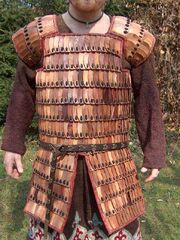(→In Deadliest Warrior: samurai have iron armor and persians have bronze scales) |
|||
| Line 11: | Line 11: | ||
Lammellar also wasn't just made of metal plates. It was also made with leather and bamboo scales. In Japan, this was a cheaper way to make a massive amount of armor for large amounts of Samurai, and was actully far more typical than one's made with metal, due to it being both cheaper and lighter. |
Lammellar also wasn't just made of metal plates. It was also made with leather and bamboo scales. In Japan, this was a cheaper way to make a massive amount of armor for large amounts of Samurai, and was actully far more typical than one's made with metal, due to it being both cheaper and lighter. |
||
==In Deadliest Warrior== |
==In Deadliest Warrior== |
||
| − | In Deadliest Warrior, a number of warriors wear lamellar armor, including [[Attila the Hun]], and the [[Mongol]]. The various tests run against these armors demonstrate lamellar's weaknesses to piercing weapons and repeated slashes. |
+ | In Deadliest Warrior, a number of warriors wear lamellar armor, including the [[Samurai]], [[Persian Immortal]], [[Attila the Hun]], and the [[Mongol]]. The various tests run against these armors demonstrate lamellar's weaknesses to piercing weapons and repeated slashes. |
| − | |||
==Lamellar being tested against multiple weapons== |
==Lamellar being tested against multiple weapons== |
||
[[Video:More leather testing - part 4: hardened lamellar armor|300px|left]] |
[[Video:More leather testing - part 4: hardened lamellar armor|300px|left]] |
||
Revision as of 18:12, 21 June 2011

History
Lamellar was a type of armor used in anicient societies all over the world from Asia to Europe. The earliest types of Lamellar where made of bronze and were held together with lacing of varying types of leather, silk, ect. Later, the armor was made of Iron and steel, but was still laced together. While it fell out of favor in the western world for chain mail and solid plate, it remained popular in Asia, especilly with the Samurai.
Advantages and Disadvantages
The advantages of Lamellar were that it offered protection against slashes and blunt force trauma; however, it was not as affective against stabbing attacks. Because it was held together with lacing, the fabrics tended to fray and the individule scales would start to fallout. Also, high humidity could cause the lacing to begin to fail. Lamellar's weakness against stabs was not due to weak metal, but to the fact the small individule plate would spread apart and allow weapons through. While new and well kept armour could stop initial stabs, over a prolonged fight the lacing again would to wear out and cause failure. Also, the lacing could be cut if repeatedly slashed in a fight and could also cause failures as well.
Materials
Lammellar also wasn't just made of metal plates. It was also made with leather and bamboo scales. In Japan, this was a cheaper way to make a massive amount of armor for large amounts of Samurai, and was actully far more typical than one's made with metal, due to it being both cheaper and lighter.
In Deadliest Warrior
In Deadliest Warrior, a number of warriors wear lamellar armor, including the Samurai, Persian Immortal, Attila the Hun, and the Mongol. The various tests run against these armors demonstrate lamellar's weaknesses to piercing weapons and repeated slashes.
Lamellar being tested against multiple weapons
300px|left
| Lamellar vs Slashing | Lamellar wins |
| Lamellar vs Piercing | Lamellar loses |
| Lamellar vs Atlatl | Lamellar wins |